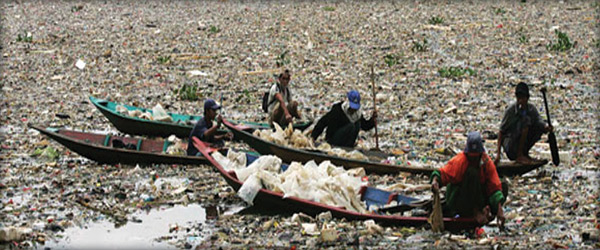It looks like you're using an Ad Blocker.
Please white-list or disable AboveTopSecret.com in your ad-blocking tool.
Thank you.
Some features of ATS will be disabled while you continue to use an ad-blocker.
share:
A Nature article published yesterday and reprinted in
Science Daily give a clear warning about the Biodiversity tipping point state
we actually are close to...
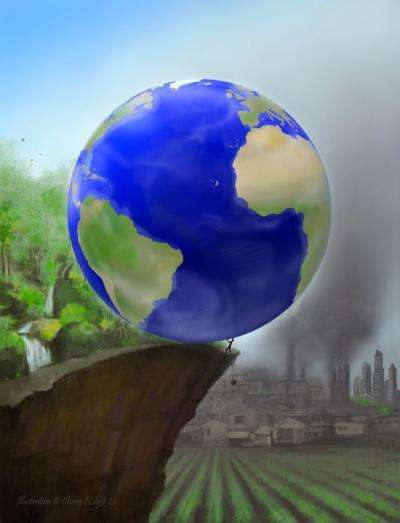
The group, of 22 internationally known scientists, gives a clear warning about what our future could be...
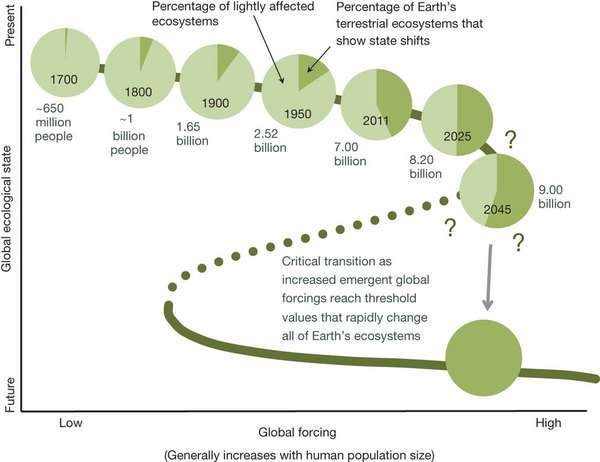
According to Barnosky, (professor of integrative biology at the University of California, Berkeley, and lead author of a review paper appearing in the June 7 issue of the journal Nature.) the tipping point will be reach when 50 percent of Earth's land surface will be converted to agricultural or urban use, with roads cutting through much of the remainder.
Actually, we are at 43% with a 7 billion population that is expected to rise to 9 billion by 2045; at that rate, current trends suggest that half Earth's land surface will be disturbed by 2025.
Then, expected changes are:
- More reduction in biodiversity (plant and animal species disappearing, new mixes of remaining species)
- Severe impacts on fisheries, agriculture, forest products and clean water.
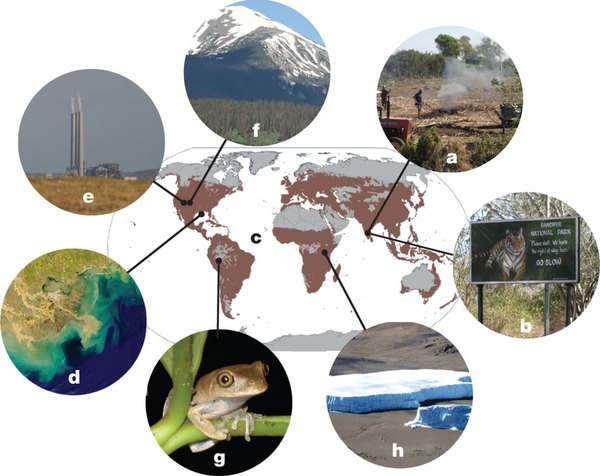
Barnosky said. "And the root cause, ultimately, is human population growth and how many resources each one of us uses."
Ok, but what about the recommendations?
When we see actually how our environment is already degraded, one can be pessimistic:
- Swirling mass of plastic soup in the Pacific Ocean:
This is one of the most important and visible result of our negligence...
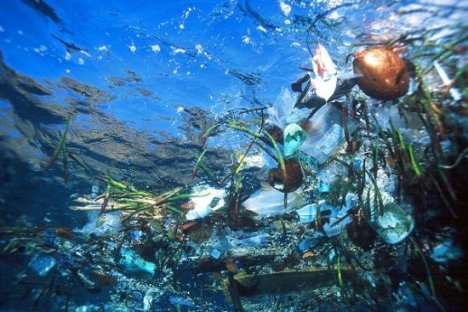
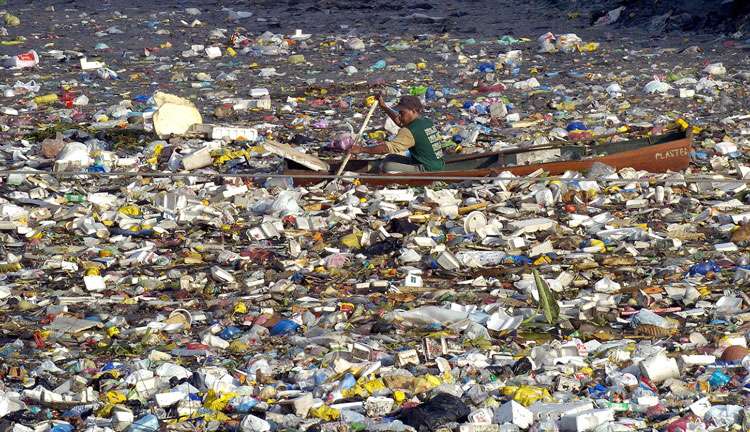
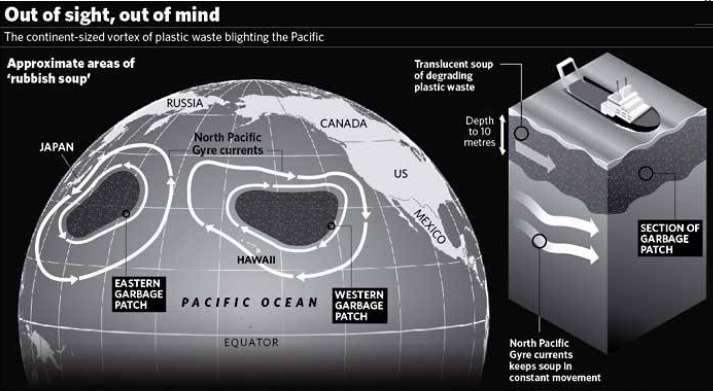
Estimates of size range from 700,000 square kilometres (270,000 sq mi) to more than 15,000,000 square kilometres (5,800,000 sq mi) (0.41% to 8.1% of the size of the Pacific Ocean), or, in some media reports, up to "twice the size of the continental United States".
Charles Moore, an American oceanographer who discovered the "Great Pacific Garbage Patch" or "trash vortex", believes that about 100 million tons of flotsam are circulating in the region.
Great Pacific garbage patch
- Loss of biodiversity
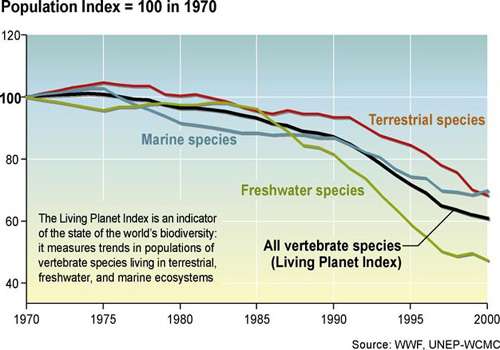
The index currently incorporates data on the abundance of 555 terrestrial species, 323 freshwater species, and 267 marine species around the world. While the index fell by some 40% between 1970 and 2000, the terrestrial index fell by about 30%, the freshwater index by about 50%, and the marine index by around 30% over the same period.
....And it only shows loss until year 2000...
Source
- Food waste
See datas and full explanations here
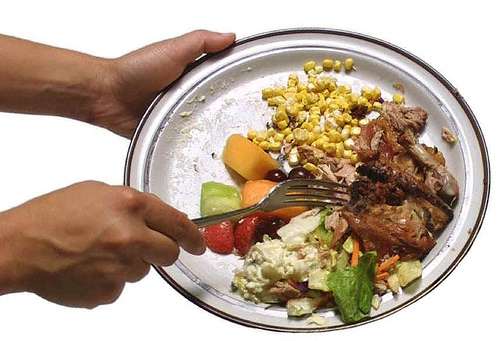
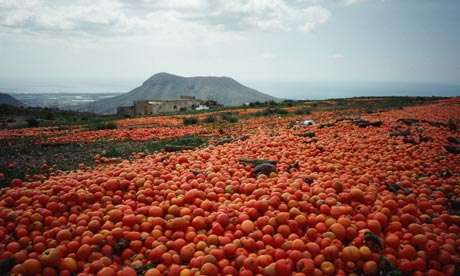
Are we strong enough and is there a real worldwide consensus to avoid the upcoming announced disaster?
A group of scientists from around the world is warning that population growth, widespread destruction of natural ecosystems, and climate change may be driving Earth toward an irreversible change in the biosphere, a planet-wide tipping point that would have destructive consequences absent adequate preparation and mitigation.

The group, of 22 internationally known scientists, gives a clear warning about what our future could be...
The authors note that studies of small-scale ecosystems show that once 50-90 percent of an area has been altered, the entire ecosystem tips irreversibly into a state far different from the original, in terms of the mix of plant and animal species and their interactions. This situation typically is accompanied by species extinctions and a loss of biodiversity.
Currently, to support a population of 7 billion people, about 43 percent of Earth's land surface has been converted to agricultural or urban use, with roads cutting through much of the remainder. The population is expected to rise to 9 billion by 2045; at that rate, current trends suggest that half Earth's land surface will be disturbed by 2025. To Barnosky, this is disturbingly close to a global tipping point.

According to Barnosky, (professor of integrative biology at the University of California, Berkeley, and lead author of a review paper appearing in the June 7 issue of the journal Nature.) the tipping point will be reach when 50 percent of Earth's land surface will be converted to agricultural or urban use, with roads cutting through much of the remainder.
Actually, we are at 43% with a 7 billion population that is expected to rise to 9 billion by 2045; at that rate, current trends suggest that half Earth's land surface will be disturbed by 2025.
...studies of small-scale ecosystems show that once 50-90 percent of an area has been altered, the entire ecosystem tips irreversibly into a state far different from the original, in terms of the mix of plant and animal species and their interactions. This situation typically is accompanied by species extinctions and a loss of biodiversity.
Then, expected changes are:
- More reduction in biodiversity (plant and animal species disappearing, new mixes of remaining species)
- Severe impacts on fisheries, agriculture, forest products and clean water.

Barnosky said. "And the root cause, ultimately, is human population growth and how many resources each one of us uses."
Ok, but what about the recommendations?
They concluded that there is an urgent need for global cooperation to reduce world population growth and per-capita resource use, replace fossil fuels with sustainable sources, develop more efficient food production and distribution without taking over more land, and better manage the land and ocean areas not already dominated by humans as reservoirs of biodiversity and ecosystem services.
When we see actually how our environment is already degraded, one can be pessimistic:
- Swirling mass of plastic soup in the Pacific Ocean:
This is one of the most important and visible result of our negligence...



Estimates of size range from 700,000 square kilometres (270,000 sq mi) to more than 15,000,000 square kilometres (5,800,000 sq mi) (0.41% to 8.1% of the size of the Pacific Ocean), or, in some media reports, up to "twice the size of the continental United States".
Charles Moore, an American oceanographer who discovered the "Great Pacific Garbage Patch" or "trash vortex", believes that about 100 million tons of flotsam are circulating in the region.
Great Pacific garbage patch
- Loss of biodiversity
Virtually all of Earth's ecosystems have been dramatically transformed through human actions and ecosystems continue to be converted for agricultural and other uses.
The current loss of biodiversity and the related changes in the environment are now faster than ever before in human history and there is no sign of this process slowing down. Many animal and plant populations have declined in numbers, geographical spread, or both. Species extinction is a natural part of Earth's history. Human activity has increased the extinction rate by at least 100 times compared to the natural rate.
Comparing different types of measurements of biodiversity loss is not simple. The rate of change in one aspect of biodiversity, such as loss of species richness, does not necessarily reflect the change in another, such as habitat loss. Moreover, some aspects of biodiversity loss are not easily measured, for instance the fact that the same species are increasingly found at different locations on the planet and that overall biodiversity is decreasing.
The Living Planet Index, compiled by the WWF, provides an indication of the declines in the overall abundance of wild species.

The index currently incorporates data on the abundance of 555 terrestrial species, 323 freshwater species, and 267 marine species around the world. While the index fell by some 40% between 1970 and 2000, the terrestrial index fell by about 30%, the freshwater index by about 50%, and the marine index by around 30% over the same period.
....And it only shows loss until year 2000...
Source
- Food waste
Food waste or food loss is food that is discarded or lost uneaten. As of 2011, 1.3 billion tons of food, about one third of the global food production, are lost or wasted annually. Loss and wastage occurs on all steps in the food supply chain. In low-income countries most loss occurs during production, while in developed countries much food – about 100 kilograms (220 lb) per person and year – is wasted at the consumption stage.
...
In the UK, 6.7 million tonnes per year of wasted food (purchased and edible food which is discarded) amounts to a cost of £10.2 billion each year. This represents costs of £250 to £400 a year per household.
A study by the University of Arizona in 2004 indicated that 14-15 per cent of United States edible food is untouched or unopened, amounting to $43 billion worth of discarded, but edible, food. Another survey, by the Cornell University Food and Brand Lab, found that 93 percent of respondents acknowledged buying foods they never used.
See datas and full explanations here


Are we strong enough and is there a real worldwide consensus to avoid the upcoming announced disaster?
edit on
7-6-2012 by elevenaugust because: (no reason given)
While I realize all this is disconcerting as hell, it's also not news. They've been warning this for the last 10+ years and no one with money seems
to care. Do you see anyone sending boats out to clean up the trash in the oceans? NO. That's the saddest part. Knowing it's all happening and the
ones who have the money to do something, don't do a damned thing except try to decide who's fault it all is.
reply to post by elevenaugust
It seems like we're too worried about what our neighbours are doing to care enough about the planet. I'm trying not to sound too
political...but...I just can't see any of our political leaders doing anything significant unless a tipping point was long past.
If, or when, that point is reached, they'll be blaming the last administration as usual.
In the meantime, it's up to the rest of us to do the cutting back and trying (in our own small ways) to leave as little harm on the environment as possible. In fact, as usual, we're all trying to get by in our lives and side-stepping the massive problems created by our wonderful leaders.
If, or when, that point is reached, they'll be blaming the last administration as usual.
In the meantime, it's up to the rest of us to do the cutting back and trying (in our own small ways) to leave as little harm on the environment as possible. In fact, as usual, we're all trying to get by in our lives and side-stepping the massive problems created by our wonderful leaders.
reply to post by Kandinsky
Well said, they(pol leaders) need to stop thinking on how to make money and turn it into something useful where all humankind will take benefits off it. Stop blaming others for there mistakes, if you are doing that you are no better.
The past is gone and it's your turn now.
It seems like they don't want to learn from mistakes just pointing fingers.
Like Opportunia said its nothing new, but what is these days, ever watched the news today and found something new about it?
Well said, they(pol leaders) need to stop thinking on how to make money and turn it into something useful where all humankind will take benefits off it. Stop blaming others for there mistakes, if you are doing that you are no better.
The past is gone and it's your turn now.
It seems like they don't want to learn from mistakes just pointing fingers.
Like Opportunia said its nothing new, but what is these days, ever watched the news today and found something new about it?
edit on 7-6-2012
by intergalactic fire because: (no reason given)
Although i agree with you overall, then i must point out that The Pacific Garbage Patch is most likely an overblown, hype to try and change public
opinion.
Originally posted by elevenaugust
- Swirling mass of plastic soup in the Pacific Ocean:
This is one of the most important and visible result of our negligence...
So... are we supposed to believe that somebody paddled out to the middle of the Pacific Ocean in a canoe?
Where did that photo really come from, anyway?
edit on 7-6-2012 by alfa1 because: (no reason given)
reply to post by elevenaugust
You do know that it is possible to reclaim deserts..... don't you ?
Hot air holds much more water than cold air. In a desert it is hot during the day (lots of water in the air) and at night it is cold (much less water in the air)..... Hot air rises and takes it's water with it... so if you trapped the hot air during the day,..... when it cools down at night it will drop it's water in the area it is trapped.....it's called condensation....... it used to be a problem on single glazed windows.... remember ?
There are better ways of taking water out of the air... and with more fresh water on land sea levels would drop.
(oh look more land)....
Yes there is enough land on earth to support more than 50billion people...... but..... then you might get to big a percentage of normal people who can see what is good for their survival and the powers that be don't want that do they.
Money can solve our problems but those with money either don't know there is a problem or they just don't care.
You do know that it is possible to reclaim deserts..... don't you ?
Hot air holds much more water than cold air. In a desert it is hot during the day (lots of water in the air) and at night it is cold (much less water in the air)..... Hot air rises and takes it's water with it... so if you trapped the hot air during the day,..... when it cools down at night it will drop it's water in the area it is trapped.....it's called condensation....... it used to be a problem on single glazed windows.... remember ?
There are better ways of taking water out of the air... and with more fresh water on land sea levels would drop.
(oh look more land)....
Yes there is enough land on earth to support more than 50billion people...... but..... then you might get to big a percentage of normal people who can see what is good for their survival and the powers that be don't want that do they.
Money can solve our problems but those with money either don't know there is a problem or they just don't care.
Originally posted by alfa1
So... are we supposed to believe that somebody paddled out to the middle of the Pacific Ocean in a canoe?
Where did that photo really come from, anyway?
edit on 7-6-2012 by alfa1 because: (no reason given)
This photo is from Chris Jordan and come from the Wasteland article
Something of this magnitude obviously has profound impacts on the ecology of the ocean. Fish are found with plastic bits in their stomachs, and photographer Chris Jordan has documented the carcasses of albatross starved to death by the copious plastic objects they swallow. He traveled to Midway Atoll, a tiny strip of land in the middle of the Pacific, that at 2000 miles distant from the nearest continent should be a wild sanctuary, free from human influence and destruction. Unfortunately, in this globalized economy, our impacts have truly become global as well. Jordan has dozens of photos of dead and decaying albatross, filled up with plastic refuse.
edit on 7-6-2012 by elevenaugust because: (no reason
given)
Originally posted by elevenaugust
This photo is from Chris Jordan and come from the Wasteland article
Not convinced.
I went to Chris Jordan's webpage and took at look at his Midway photography exhibit, and not a single one of the photos looked like the one in question.
The wastelands article uses the unknown photo as an introduction to the gyre (like every other environmental site on the net), before then referencing the travels of Chris Jordan. Note the questionable photo isnt even in the same aspect ratio as Chris' works.
Edit - back in 2006, years before Chris ever went to Midway for his photography, somebody posted that exact picture on a message forum, here
The caption, translated, is Filipino rowing his boat across a sea of garbage along the waterway in the capital, Manila.
Also named as Manila at this site.
edit on 7-6-2012 by alfa1 because: (no reason given)
The floating garbage problem, where are Greenpeace, The Sierra Club, Nature Conservancy etc.? So much money they collect............. The irony of
saving a whale, so it can live in a toilet is not lost.
As for the other problems. Blaming politicians is like waiting for them to do something, futile. If we voted the way we run our mouths then a green candidate would be in all the Congress and Senate seats, even the White House, but it isn't so, so it must be that we value our consuming and wasting lives more.
We are the problem, so we as individuals need to be the solution. Stop wasting food and be more mindful of the containers you buy your food in. Demand plastics that breakdown from manufacturers. I have to laugh every time I see a Johnson and Johnson commercial blabbing about how environmental they are with all their plastic bottles!
As for whether it is to late or not. I personally believe it is never to late. There is always hope.
As for the other problems. Blaming politicians is like waiting for them to do something, futile. If we voted the way we run our mouths then a green candidate would be in all the Congress and Senate seats, even the White House, but it isn't so, so it must be that we value our consuming and wasting lives more.
We are the problem, so we as individuals need to be the solution. Stop wasting food and be more mindful of the containers you buy your food in. Demand plastics that breakdown from manufacturers. I have to laugh every time I see a Johnson and Johnson commercial blabbing about how environmental they are with all their plastic bottles!
As for whether it is to late or not. I personally believe it is never to late. There is always hope.
Originally posted by alfa1
Not convinced.
I went to Chris Jordan's webpage and took at look at his Midway photography exhibit, and not a single one of the photos looked like the one in question.
The wastelands article uses the unknown photo as an introduction to the gyre (like every other environmental site on the net), before then referencing the travels of Chris Jordan. Note the questionable photo isnt even in the same aspect ratio as Chris' works.
I believe it actually to be an image of the Citarum river, Indonesia.
edit on 7-6-2012 by alfa1 because: (no reason given)
I checked it again, and you're absolutely right.
The photo came from Manila Bay, Philippines and was reposted everywhere without any verification.
Too late to correct my first post though...
Thanks a lot for the verification, it's always good to be the most accurate as possible!
Anyway, it's just an illustration on how things are going bad with all the plastic pollution all around the world.
And what are your thoughts on the article content?
edit on 7-6-2012 by elevenaugust because: (no reason given)
That image, widely mislabeled as a shot of the Pacific garbage patch, is actually from Manila harbor. And it's just one of many misconceptions the
public has about what's really happening to plastics in the ocean.
Originally posted by elevenaugust
Anyway, it's just an illustration on how things are going bad with all the plastic pollution all around the world.
True.
Originally posted by elevenaugust
And what are your thoughts on the article content?
I agree completely. I've always felt the world is overpopulated and it simply cant go on like this forever.
But like the Monsanto issues I've mentioned in other threads, I also think the issue is bad enough to stand as an issue as fact in its own right, and nobody (and I dont mean you here, I really mean websites and organisations that do this full time) should have to tell lies to make it sound worse.
It already is.
I guess that one of the main component of the Pacific Garbage Patch are the
nurdles, also known under the poetic name of "Mermaid's tears".
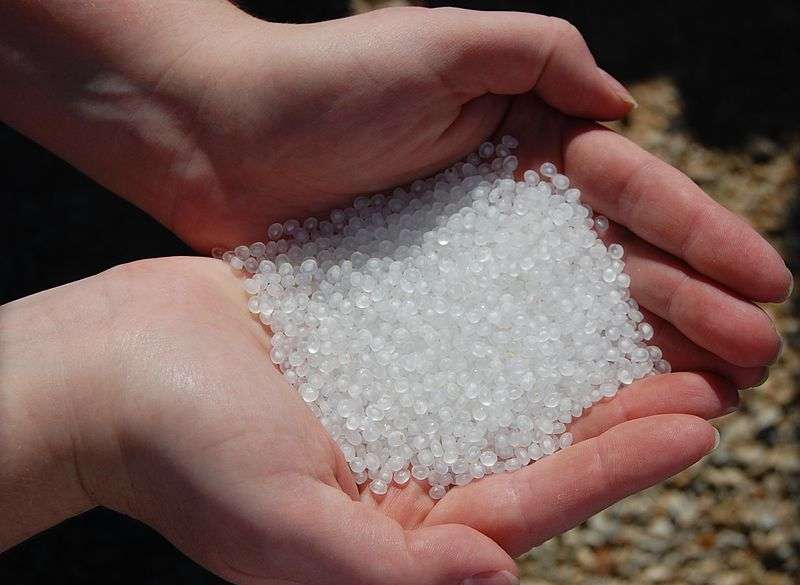
Nurdles are pre-production plastic resin pellet typically under 5 mm (0.20 in) in diameter found outside of the typical plastics manufacturing stream...
reply to post by Iamschist
Wise words, as usual, Iamschist!

Nurdles are pre-production plastic resin pellet typically under 5 mm (0.20 in) in diameter found outside of the typical plastics manufacturing stream...
Nurdles are a major contributor to marine debris. During a three month study of Orange County beaches researchers found them to be the most common beach contaminant. Nurdles comprised roughly 98% of the beach debris collected in a 2001 Orange County study.
reply to post by Iamschist
Wise words, as usual, Iamschist!
edit on 7-6-2012 by elevenaugust because: (no reason given)
Originally posted by WiseThinker
Although i agree with you overall, then i must point out that The Pacific Garbage Patch is most likely an overblown, hype to try and change public opinion.
No, it exists. The video you post even says so. It's merely explaining that it isnt 'one giant patch' of garbage, but rather a very large, spread out collection of plastics floating i the Pacific Gyre.
Get rid of government, turn to bugs for food and start cleaning up the environment OURSELVES. We humans have to stop relying on
organizations/governments, start thinking on our own! They only care about money and degrading the quality of life for us. Governments like to pretend
they're stupid, they know there are many ways of combating what they're allowing but they continue with this whole sham that there's too many of us
or that life will soon crap out. We don't have to follow down a path that was already set for us.... if we continue then government will keep
shifting society in the ways they want. Until then we are not awake, talking online does NOTHING. And until I see magic happen through the power of
thought it's just the same as sitting around.
Horsefeathers......
Firstly, that huge patch of plastic mid pacific is about a convenient pick up point for a mobile water bourne plastics factory aflaoat....maybe even two or three!
Secondly, we need to plant trees!
Everywhere!
TREES! they are the answer to the probem....
Fruit bearing trees where possible.... and other species in mixed forests all over the planet........
There is nothing better in theis chain of life than an entity which stores clean wwater, eats COs, and provides shelter and habitat for much of the worlds fauna and flora....TREES!
Everyone should be involved from cradle to grave planting, tending, harvesting, utilising.
Hemp! another crop for which a miliopn uses can be found...from medicine to newsprint to fabrics with decades of wearability and strength.....
remember Nylon was invented to replace good old hemp ropes.....
But there are myriad uses for this plant awhich are , pardon the pun, green as grass....
Time to shift our focus from users to sustainers.....members of a chain which we strengthen rather than break to reap short term rewards.....
Firstly, that huge patch of plastic mid pacific is about a convenient pick up point for a mobile water bourne plastics factory aflaoat....maybe even two or three!
Secondly, we need to plant trees!
Everywhere!
TREES! they are the answer to the probem....
Fruit bearing trees where possible.... and other species in mixed forests all over the planet........
There is nothing better in theis chain of life than an entity which stores clean wwater, eats COs, and provides shelter and habitat for much of the worlds fauna and flora....TREES!
Everyone should be involved from cradle to grave planting, tending, harvesting, utilising.
Hemp! another crop for which a miliopn uses can be found...from medicine to newsprint to fabrics with decades of wearability and strength.....
remember Nylon was invented to replace good old hemp ropes.....
But there are myriad uses for this plant awhich are , pardon the pun, green as grass....
Time to shift our focus from users to sustainers.....members of a chain which we strengthen rather than break to reap short term rewards.....
It was probably too late when Rachel Carson published Silent Spring. Our only hope: Divine Intervention.
we're screwed and the fact that the media doesn't even talk about climate change anymore doesn't help the situation. people have become
complacent and fox news has TOTALLY screwed up any hope we had of trying to slow this down.
i was hoping to have grandchildren but by the time my kids are ready to have kids they probably won't want to bring kids into this world.
i was hoping to have grandchildren but by the time my kids are ready to have kids they probably won't want to bring kids into this world.
Originally posted by pasiphae
i was hoping to have grandchildren but by the time my kids are ready to have kids they probably won't want to bring kids into this world.
I already don't and I am 30. I just don't see the point of bringing up a generation into hell.
new topics
-
Gen Flynn's Sister and her cohort blow the whistle on DHS/CBP involvement in child trafficking.
Whistle Blowers and Leaked Documents: 4 hours ago -
Anybody else using Pomodoro time management technique?
General Chit Chat: 7 hours ago -
Bucks County commissioners vote to count illegal ballots in Pennsylvania recount
2024 Elections: 9 hours ago -
Trump sues media outlets -- 10 Billion Dollar lawsuit
US Political Madness: 10 hours ago -
Fired fema employee speaks.
US Political Madness: 10 hours ago
top topics
-
Trump sues media outlets -- 10 Billion Dollar lawsuit
US Political Madness: 10 hours ago, 23 flags -
Bucks County commissioners vote to count illegal ballots in Pennsylvania recount
2024 Elections: 9 hours ago, 20 flags -
How long till it starts
US Political Madness: 12 hours ago, 17 flags -
USSS Agent Fired for Having Sex In Michelle Obama's Bathroom
Politicians & People: 13 hours ago, 10 flags -
Watching TV
Jokes, Puns, & Pranks: 16 hours ago, 9 flags -
Fired fema employee speaks.
US Political Madness: 10 hours ago, 9 flags -
Gen Flynn's Sister and her cohort blow the whistle on DHS/CBP involvement in child trafficking.
Whistle Blowers and Leaked Documents: 4 hours ago, 6 flags -
Anybody else using Pomodoro time management technique?
General Chit Chat: 7 hours ago, 3 flags
active topics
-
How long till it starts
US Political Madness • 17 • : WeMustCare -
USSS Agent Fired for Having Sex In Michelle Obama's Bathroom
Politicians & People • 24 • : rickymouse -
The Acronym Game .. Pt.4
General Chit Chat • 962 • : FullHeathen -
TRUMP Could Be Our Modern Day MOSES - The Similarities are Striking.
ATS Skunk Works • 246 • : WeMustCare -
Bucks County commissioners vote to count illegal ballots in Pennsylvania recount
2024 Elections • 18 • : rickymouse -
Anybody else using Pomodoro time management technique?
General Chit Chat • 7 • : tamusan -
The Trump effect 6 days after 2024 election
2024 Elections • 141 • : cherokeetroy -
Thanksgiving 2024
Member Art • 19 • : rickymouse -
President-Elect Donald Trump will Meet with Coup-Victim JOE BIDEN on Wed 11.13.2024.
2024 Elections • 35 • : WeMustCare -
Mike Tyson returns 11-15-24
World Sports • 46 • : argentus

